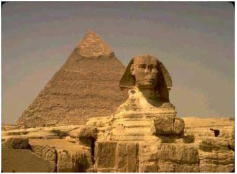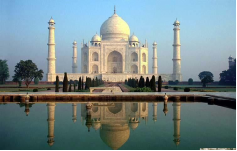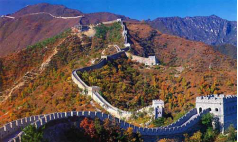课前准备 Warm-up
What is culture? Culture is like an iceberg, only some of culture is visible. Culture is our software, the basic operating system that makes us human. Culture is like the water a fish swims in. Culture is the story we tell ourselves about ourselves. The world is diversified and the cultures are of great variety. This unit is going to tell what will happen when different cultures meet.
Discuss the following pictures.




What does each picture show? Where might these structures be?
Hints: The first picture exhibits a typical Greek style temple.
The second picture is the Great Pyramid of Khufu and the Great Sphinx in Egypt.
The third picture is the famous Taj Mahal Mausoleum in India.
The last picture is the Great Wall in China.
What cultural information do they involve?
Hints:
Greek Temple: Generally, the Greeks built temples closer to the ground with space inside the temple for worshipers. The Roman temple was built with space for worshipers outside in a courtyard. The temple was high off the ground and only the priests were allowed inside. Most religious buildings today are for groups of people get together to celebrate their god and receive spiritual comfort. Ancient Greek temples were rarely used this way. They were meant to serve as homes for the individual god or goddess who protected the community. The needs of the gods were the most important as they controlled the forces of nature. In order to avoid the anger and jealousy between gods or goddesses, there is usually one god or goddess in a temple represented by an image, a seated or standing statue, which occupied the central place.
The Great Pyramid of Khufu and the Great Sphinx: The great pyramid is believed to have been builtover 20 years. The site was first prepared, and blocks of stone were transported there later. According to a rough estimate, 2 million blocks of stones, each weighing more than 2 tons, were used to build this wonder. The coffin of the pharaoh, made of red granite 花岗岩, lay at the heart of the pyramid. The Great Sphinx sitting right in front of the pyramid was the most powerful guardian of the pharaoh’s body and spirit. It is a creature with a human head or a lion’s body. In ancient Egypt, the country was always wreathed in scorching sunlight; therefore, the sun was regarded as the powerful Creator. The Pharaoh was the son of the sun god, represented the sphinx. Its human head stands for the king’s wisdom while the body of the lion symbolizes the highest power laid in the king’s hands. Thus, the lying sphinx before the pyramid was meant to instruct people on the pharaoh’s majesty and power.
Taj Mahal Mausoleum: One of the architectural wonders in the world, it was built in 1631 after 22 years’ hard work of more than 20,000 laborers. The entire body of the mausoleum was made of white marbles, as white was the king’s favorite color. Besides the wonderful view of the site, the beautiful love story behind the construction of this structure is even more attractive, as the name of this wonder was the name of the king’s favorite woman, who died in her childbirth of the fourteenth child. On her deathbed, she left three wishes to the king Shah Jahan. The king should take good care of the children, never to remarry, and build a beautiful mausoleum for her. A man of his word, the king built this famous structure for his beloved wife. It is said that the king later tried to build a black mausoleum of the same style right opposite to Taj Mahal to be connected in between by a marble bridge of half black and half white so that they could behold each other after his death. However, the revolt of his son destroyed his plan and ended up in 8 years’ imprisonment of the king in a castle not far from Taj Mahal, where through a little window he could enjoy the beautiful image of the mausoleum reflected in the river until his death.
Whatis so special about Taj Mahal is that its view differs at different times of the day. And the ticket varies accordingly, with 20 rubles during the daytime but 110 rubles after 5 o’clock in the evening. Generally speaking, the view in the evening is the most wonderful, with the color changing from yellowish grey then golden to pink and finally silver white in the pure moonlight.
the Great Wall: It is one of the largest building-construction projects ever carried out, running about 7,300 km east to west from Shanhai Pass 山海关to Jiayu Pass嘉峪关. Large parts of the fortification date from the 7th through the 4th century BC. In the 3rd century BC Qin Shihuang, the first emperor of a united China (under the Qin dynasty), built this wall out of military strategic concern, in checking the advance of the Manchu invaders in the seventeenth century. The Great Wall became a UNESCO World Heritage site in 1987. Today, the Great wall has lost its strategic importance and has become a world-renowned tourist attraction. The laboring people of different dynasties demonstrated to the whole world their intelligence and wisdom.
Compare them with the modern buildings. What feelings can you get?
Hints: The comparison can be made in the following aspects:
The materials the buildings are made of or from
The styles of the buildings
The ways in which they are built and the time needed to complete the building
The purpose and function of the buildings
The size or scale of the buildings
本章概览 An Overview
This unit introduces the great cultures of the world. Passage one is stating various opinions about the meaning and importance of the concept of “culture”. Passage two tells three stories. The first one is about greetings and introductions. The second one is about eating and drinking with people from other cultures. The third one is about Body language—gestures, hand movements and facial expressions.
学习目标 Objectives
Through discussion and learning, the students should
Acquire key words and expressions in talking about world cultures
Get a general idea of the great cultures all around the world
Be able to use the words and expressions in discussion
知识结构 Knowledge Structure
Passage One Cross-Cultural Conversation
Alain and Werner‘s opinion on culture
Kamil and Jade’s opinion on culture legacy
Kevin and Ken’s opinion on culture
Monika’s opinion on culture
Passage Two Clues to World Cultures
Greetings and introductions
Visiting a family at home;
Body language—gestures, hand movements and facial expressions

